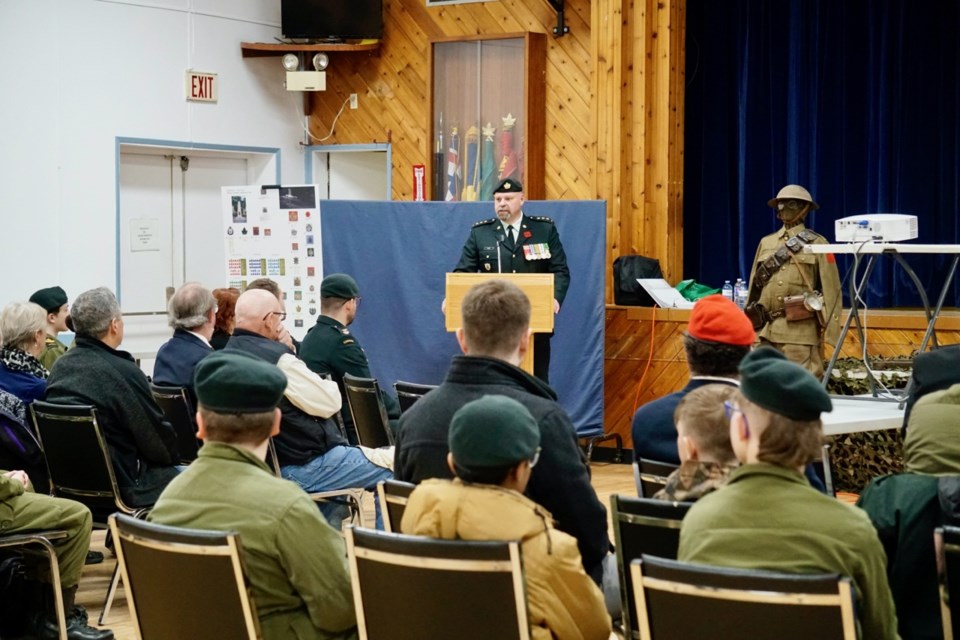ESTEVAN — Capt. Craig Bird – Estevan military historian, president and curator of the South East Military Museum, and commanding officer for the No 2901 Estevan Princess Patricia's Canadian Light Infantry (PPCLI) Army Cadets – paid tribute to the Battle of Vimy Ridge, marking its 106th anniversary.
The historic presentation that attracted many people took place at the Royal Canadian Legion Hall in Estevan on Sunday. Bird recollected the events of April 9-12, 1917, addressed the value of the battle for Canada and for the rest of the world, and also focused on Saskatchewan's as well as the southeast's involvement with this crucial point of the Great War.
This year the event attracted cadets from various parts of the province. Young guests came from Regina, Moose Jaw and Montmartre, and were joined by local air and army cadets, Army Cadet League members, the general public, and legion members from Kisbey, Carlyle and Estevan.
The presentation was originally intended for the cadets, but Bird opened it up to the public to keep the memories and knowledge about the important battle going.
"I think it's important that we remember all of these people and these events because there's very few of the World War Two veterans left, we have no World War One veterans alive anymore, and all of this information … seems to be getting lost somewhere in the mix," Bird said.
Bird provided the overall picture of the Battle of Vimy Ridge, and then broke it down into Saskatchewan components. As part of the presentation, he demonstrated a video called Storming the Ridge done by Norm Christie. The documentary illustrated what happened during those days of 1917 in France as four Canadian divisions accomplished what the British and the French couldn't, dislodging the Germans from the ridge.
Most of the casualties occurred on April 9, which was Easter Monday, Bird noted. Twenty thousand Canadian soldiers, carrying equipment and ammunition, attacked to remove the Germans from their position. There was sleet and rain at the start of the day, and trying to advance would have been difficult.
Most gains occurred on the first day, but Canadians still had to take a hill known as the pimple, which provided more resistance than anywhere else. Princess Patricia's Canadian Light Infantry and the Royal Canadian Regiment were the main forces that attacked the hill, and suffered great casualties, but on the fourth day they were able to victoriously capture all of that area.
"There were over 10,000 Canadian casualties and 3,500 that were killed," Bird said.
With people from different areas in attendance this year, Bird talked more about Saskatchewan's role in the battle rather than just the southeast's as he would usually do. He pointed out that out of 3,598 lives lost during the battle, 412 soldiers were from Saskatchewan. On April 9, 279 Saskatchewan soldiers were killed in action. On April 10, 72 men's lives were lost, on April 11, 20 more, and on April 12, another 41 soldiers were killed.
"Every small community [in Saskatchewan] pretty much got touched by the Battle of Vimy Ridge," said Bird.
The Princess Patricia's Canadian Light Infantry saw 83 killed during the battle with another 139 listed as casualties.
"It was commented by the commander of the Princess Patricia's Canadian Light Infantry, 'Unlike previous costly battles that had often seemed senseless, Vimy Ridge was a brilliant success for the Canadian core, and a triumph for the PPCLI,'" read Bird.
He also talked about acts of valour and military medal award recipients from the area, including Sgt. Reginald Lavers, PPCLI, from Saskatoon; Sgt. Stanley Ridley, PPCLI, from Moose Jaw; Priv. Frederick Crahart, 5th Battalion CEF, from Macoun; and Corporal Robert Marshall, 5th Battalion CEF, from Regina.
Four Victoria Crosses, which is the highest and most prestigious award of the British honours system, were awarded to members of the Canadian Forces during that battle, with one going to Saskatchewan resident Priv. William Milne, 16th Battalion CEF, from Mortlach.
To give guests a better understanding of what soldiers were going through during the Battle of Vimy Ridge, Bird also read from war diaries of some of the Saskatchewan participants of the battle and demonstrated another video capturing voices of Canadian soldiers talking about their war memories.
"Canada's military achievements during the war raised our international status and helped earn us a separate signature on the Treaty of Versailles that was formally ending World War One. Today on land granted to Canada for all time by a grateful France, the Canadian National Vimy Memorial sits atop Hill 145, rising above the now quiet countryside," Bird said.
"This great monument is inscribed with the names of 11,285 Canadian soldiers who are listed as missing and presumed dead in France and throughout the course of the First World War. It stands as a tribute to all that had served our country in the conflict and paid the ultimate price to help ensure the peace and freedom that we enjoy today."
The presentation was followed by a lunch at the legion, sponsored by the Army Cadet League this year. Then guests gathered at the cenotaph on Fourth Street for a wreath-laying service in memory of those killed during the battle. To commemorate the 106th anniversary of the Battle of Vimy Ridge, the current Canadian flag at the cenotaph was replaced with the Red Ensign as it was flown by Canadian troops during and after the battle.


